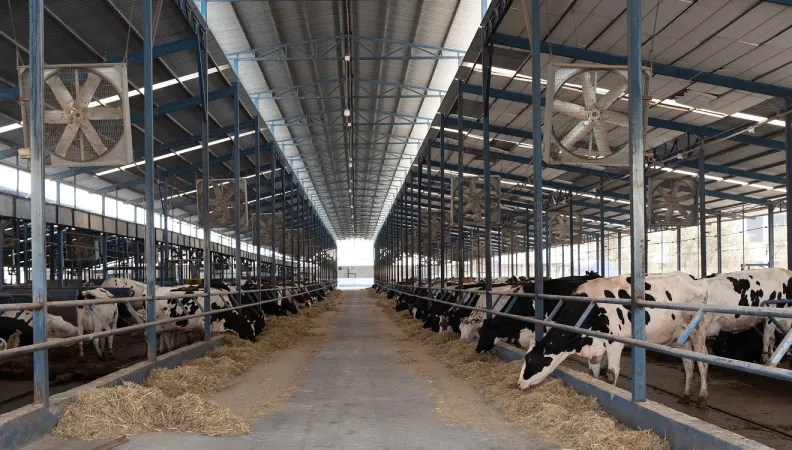Share the page
Promoting a Greener, More Robust Livestock Sector in Uzbekistan
Published on

A new AFD-funded project to support livestock farmers is being launched in Uzbekistan. The challenge is to structure the livestock sector to sustainably meet the growing demand for animal products while reducing livestock imports and encouraging investment in greener equipment.
In the arid Kashkadarya region of southeastern Uzbekistan, it is not uncommon to see herders grazing their herds of cows and sheep along the roads. The small farmers, called dekhans, do not have enough space to feed their animals on their own plot of land, usually a half-hectare adjoining their home. Yet, despite limited resources and high levels of poverty, the dekhans provide 90% of the national meat and dairy production. A significant contribution for a country where the livestock sector represents 13% of GDP.
Uzbekistan's economy is growing rapidly and the purchasing power of its inhabitants is increasing as well as their consumption of animal products. Growing demand is driving cattle imports from Europe, which are considered more productive for milk and meat. While an Uzbek cow produces less than 3,000 liters of milk per year, a European cow produces more than 7,000 liters. However, a harsher climate and unsuitable animal feed have affected the imported breeds, resulting in product yields that are lower than expected. Animal imports also contribute to the livestock sector's carbon footprint, which alone accounts for 13% of the country's greenhouse gas emissions.
"To prevent an increase in carbon dioxide emissions, we must encourage investments in sustainable equipment for the entire sector,” says Jamshid Jalilov, an economist with Uzbekistan's State Veterinary and Livestock Development Committee.
Clément Lapointe, AFD’s Project Manager for livestock in Uzbekistan, stresses the importance of raising productivity without increasing the number of animals. "This involves improving the quality of feed, reducing losses by paying attention to phytosanitary conditions and the cold chain,” he said, “and by optimizing the equipment used by farmers and encouraging the use of renewable energy.”
Investments that benefit the climate
Most of the €100 million credit made available to the Uzbek government by AFD will be transferred to local banks that will offer loans at preferential rates to livestock sector stakeholders. They will be able to use the funds to make investments deemed climate-smart, which will help improve productivity while reducing the sector's carbon footprint. Investments target everything from equipment to improve feed production and tools to improve buildings’ energy efficiency, to improved storage facilities, irrigation equipment and better-insulated infrastructure for storing feed.
"This is very expensive equipment, such as methanation units or more efficient equipment for processing animal products, which is not normally available to farmers,” says Jamshid Jalilov. “These loans will make it possible to buy them.” The financial aid will help make the livestock sector greener and more sustainable, particularly in light of the growing climate risks.
Inclusive financing
Small farmers have difficulty accessing loans because they often do not have the necessary guarantees required by banks to take out a loan, and without financing it’s almost impossible for them to invest and develop their business. This perpetuates their financial instability.
By facilitating their access to loans and increasing their income, this AFD-backed project, aims to boost the inclusion of dekhans in the livestock sector. To achieve this, part of the credit line, amounting to €24 million, is exclusively dedicated to small farmers. To encourage them to take out loans, an investment subsidy from European funds covering up to 25% of the loan amount will be paid to dekhans who invest in climate-friendly equipment. This investment subsidy also favors farms run by young people and women in order to increase the diversity of the breeders' profiles.
A partnership with the Uzbek fund for the development of entrepreneurship will compensate for the difficulty they have in providing guarantees to banks when applying for a loan. This fund covers up to 50% of the guarantee amount and up to a 5% interest rate. There are also plans to provide banks with technical assistance to promote this line of credit to eligible breeders. Technical assistance is also planned for farmers' associations to support small farmers and raise awareness of the usefulness of such financing.
"These mechanisms will certainly encourage dekhans to join together to apply for joint loans," says Clément Lapointe. The project aims to "encourage farmers to buy equipment together, create cooperatives, especially in sectoral clusters,” whether in the production of milk or its processing into butter, yogurt and cheese."
Forming such partnerships affords dekhans more protection and greater income stability – in an often volatile agricultural sector. By reinforcing the resilience of small farmers, this project will contribute to structural change in the Uzbek agricultural economy.
